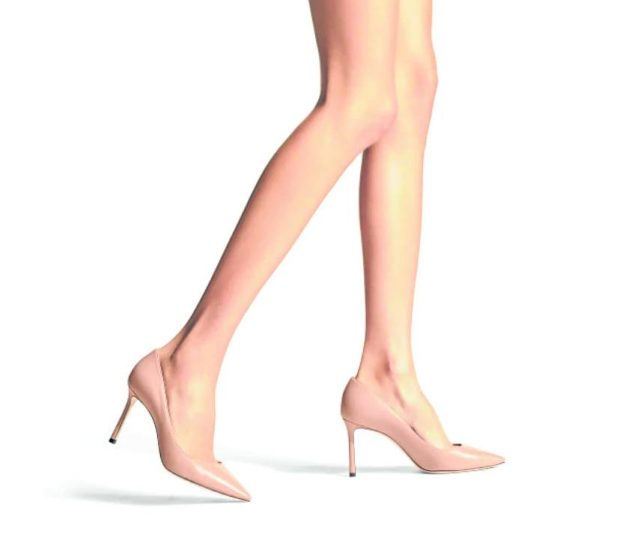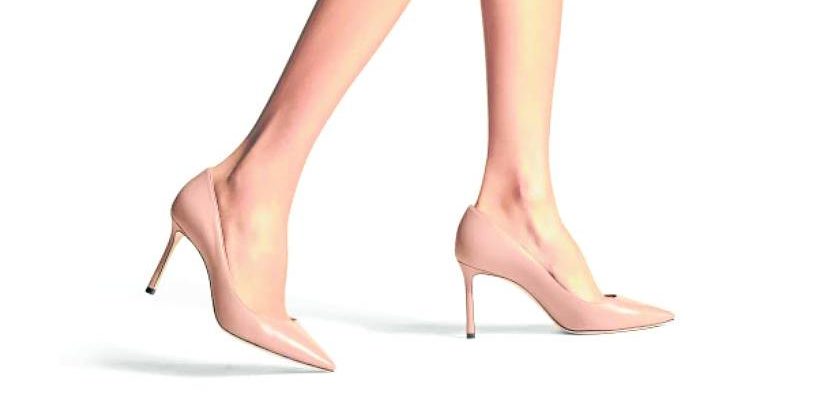In November, I attended my first in-person event after over a year. It was a sit-down dinner, and dress code was business. I wore what I thought were sensible, comfortable shoes—soft kid leather Jimmy Choo pumps with 85-millimeter (roughly 3.3-inch) heels.
No sooner had I stepped out the door than I realized my folly. I felt a burning sensation on the balls of my feet, and a tingling pain radiated from my soles to my knees.
My shoes were sensible and comfortable prepandemic, but after living in Birkenstocks and the occasional sneakers for almost two years, I not only couldn’t walk in high heels anymore, I was no longer immune to the pain of walking on tiptoes! I wobbled like a newborn giraffe learning to walk.
By end of the night, I lost balance and tripped when my heel got caught on a rug. Thankfully, only a few people saw it, and the blow to my ego hurt more than the pain on my butt.
Break in your shoes, feet—again
“You need to retrain your feet and practice walking in heels again, especially if you haven’t worn your shoes for a long period,” said Dr. Carlo Angelo Borbon, president of the Philippine Orthopaedic Foot and Ankle Society and training officer at Makati Medical Center’s Department of Orthopedics.
In a sense, both your feet and your shoes need breaking in again.
Borbon, a sports medicine and foot and ankle surgery specialist, said it’s not uncommon to hear from patients about their struggles wearing high heels, especially after the pandemic, when people had gotten used to wearing only slippers. Now that we’re slowly easing back to normal routines, reporting for work in offices where there are dress codes, he foresees this to be a continuing issue.

“There’s a difference in biomechanics between wearing flat shoes and high heels,” Borbon explained. “That’s where the flexibility of your calf muscles, Achilles tendon and plantar fascia come in. These are structures that are usually very flexible. The problem is, if you were less active during the pandemic and you didn’t exercise, you lose the flexibility of these structures.”
This means that it will be harder for you to adjust to wearing shoes, even if, like me, you were used to wearing stilettos.
What to do
To get your feet and legs back into high-heels shape, Borbon advises doing proper calf stretches and lunges before attempting to slip back into your old work shoes.
Relearning balance is also important, he added. “If you’ve been wearing only flat shoes, you tend to forget the balance, because the mechanics of wearing heels is different.”
Wearing heels shortens and puts pressure on the Achilles tendon, the structure that connects the calf muscle to the heel, Borbon said. Because you’re tiptoeing, you bring the heels closer to the knee, and this repeated movement causes inflammation and pain.
Flats or ballet shoes, or any footwear without arch support, however, are not always the right solution, he added. While most sneakers now also have built-in arch support, Borbon recommends adding arch inserts for footwear that have none.
In fact, he said, high heels may have some advantages. Wearing them tones one’s calf muscles, for one. The downside is, it also makes you tire easily.
For women who wear heels to work, Borbon recommends no more than two inches in heel height. And, most importantly, the shoes have to have a roomy toe box.
“But I know that’s the kind of shoes women want, those with narrow, pointed tips, because they’re aesthetically pleasing. Nobody wants to wear Ronald McDonald shoes,” he noted. “But these narrow shoes constrict your toes.”

I should know—I have narrow feet and no bunions, and yet pointy shoes really do hurt like hell, especially if you’ve been on your feet all day. I attended a wedding early last year and used social distancing as an excuse to not mingle during cocktails. Truth was, it was hard to make conversation when you’re silently wincing from the pain caused by your beautiful five-inch stilettos.
Bunion pain
Borbon, however, dispelled notions that your feet tend to get bigger if you’ve been wearing only slippers at home, so you no longer fit in your old shoes. “Not true,” he stressed. “Maybe your feet got fat or are swollen, but they didn’t grow a size bigger.”
The reason people think their feet got bigger is because, when you haven’t worn your shoes in a year, it really feels tight when you wear them again. “That’s why marathoners don’t wear brand-new shoes during a marathon. They run with it maybe 10 times first during training, to give the shoes time to accommodate the feet.”
The most common high heels-related issue in Borbon’s clinics is bunion pain, referring to the bony lump that protrudes on the joint of the big toe. Bunions are a deformity aggravated by wearing narrow, ill-fitting shoes.
“You know, fashion over comfort,” he said wryly. “The higher the heels, the more your feet point down and majority of the pressure is on the ball of your feet, or the side where your bunion is. If you have bunions, the pain is greater because the bone protrusion is more prominent.”
To ease the pressure, he advises using gel foam inserts for the shoes, like those designed for the ball of the feet, to reduce the friction. He recommends metatarsal pads or orthotic insoles for those with bunions.
To avoid injury wearing high heels, Borbon emphasized the need to train and practice wearing them at home. Regular exercise—which I stopped doing for most of the pandemic—helps with balance and flexibility.
At the end of a long day in heels, soak your feet in a bucket of warm water for five to 10 minutes. Some like to add Epsom salt, which is said to have anti-inflammatory properties, though Borbon said warm water should suffice for a relaxing soak.
“If you have plantar fasciitis, or pain on the ball of your feet, get a golf ball and roll your feet on it against a hard surface,” he said. “Do also your stretches early in the morning,” he added.
So, that’s what I’ll be doing, even as I continue to work from home. Now, excuse me as I go walk my dog—in high heels. INQ









































